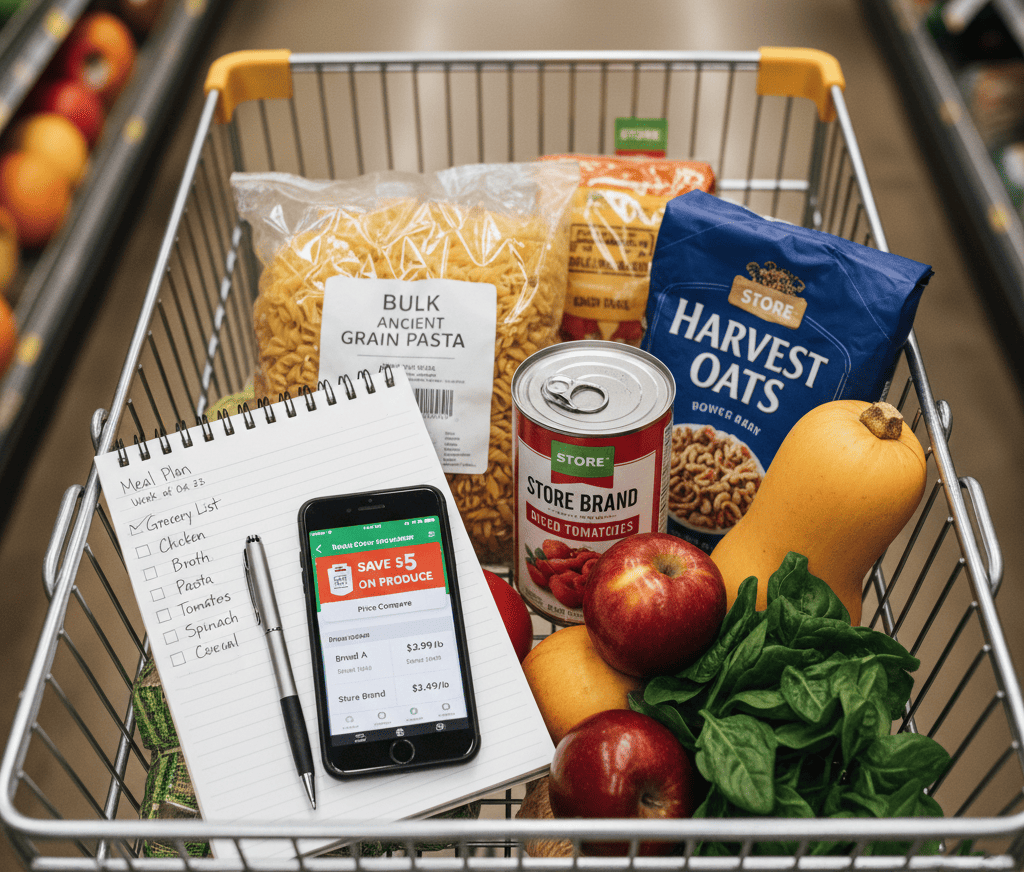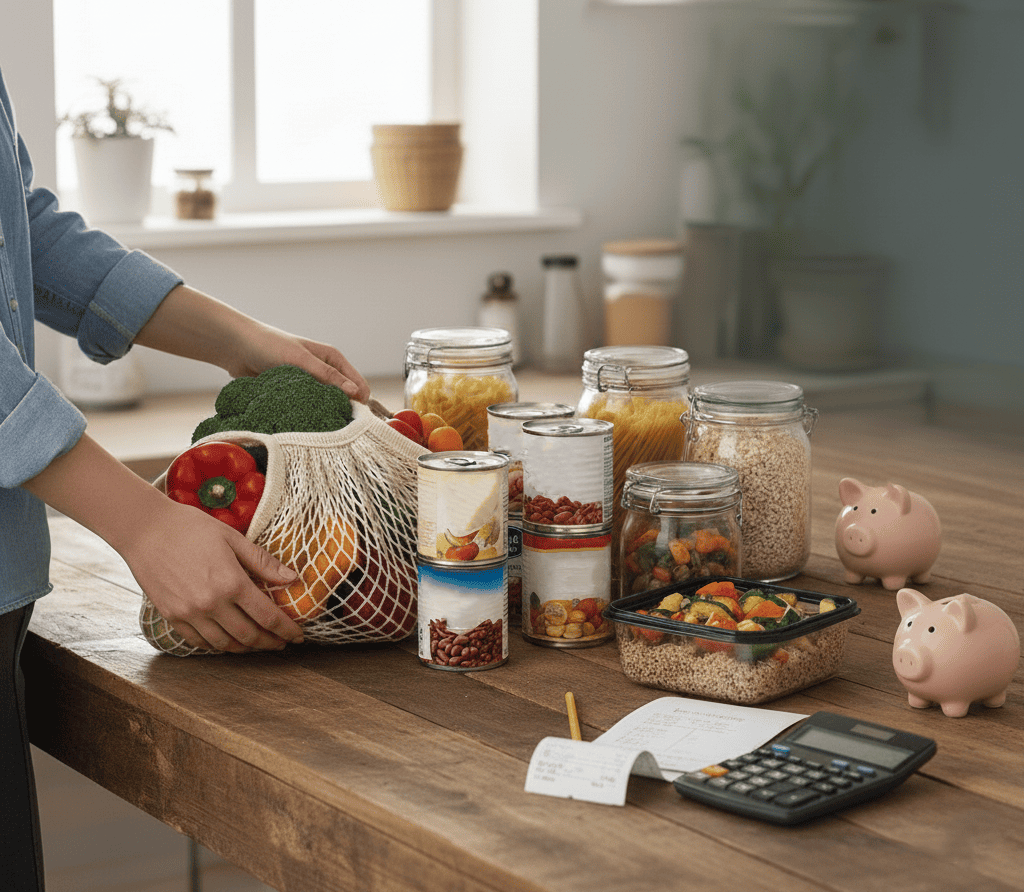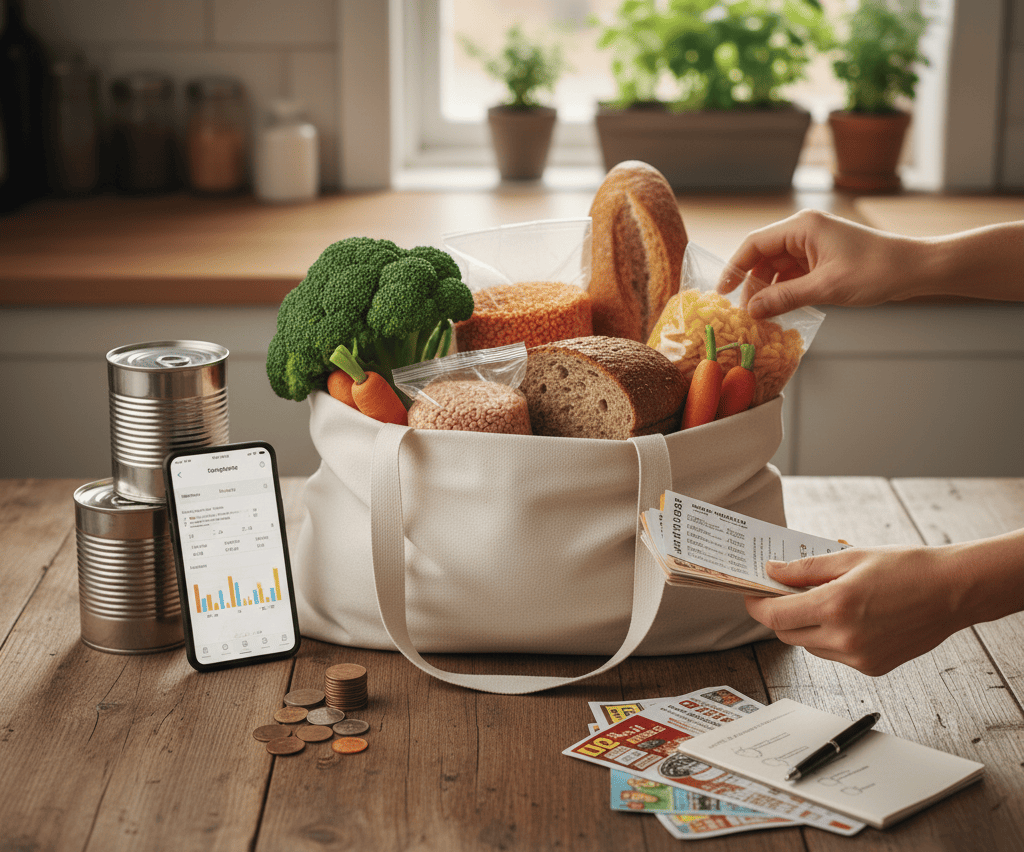Quick Quiz: What’s Your Grocery-Saving Style?
Answer step by step. Your result will appear at the end.
In 2025, the cost of groceries has become one of the most pressing financial challenges for households across the United States. Rising inflation, supply chain disruptions, and shifts in consumer demand have all contributed to higher prices on everyday essentials such as dairy, bread, produce, and proteins. For many families, the grocery bill has surpassed other recurring expenses like transportation or insurance, making it a primary focus in monthly budgeting discussions. The question of how to save money on groceries is no longer just about finding a few dollars of relief - it has become a necessity for maintaining financial stability.
What makes this year particularly difficult is the unpredictability of food pricing. Seasonal variations have become sharper, store promotions less generous, and package shrinkage more common, meaning shoppers often pay more while receiving less. Without a structured approach, households risk overspending hundreds of dollars each year on unnecessary items or inefficient shopping habits.
At the same time, the tools, apps, and strategies available to consumers have never been more advanced. From digital coupons and price comparison platforms to community-supported agriculture and rebate programs, 2025 offers a wide range of opportunities for disciplined shoppers to reduce expenses.
By adopting smarter shopping behaviors, families and individuals can build sustainable habits that consistently lower their grocery bills while still maintaining variety, nutrition, and quality in their diets.
Listen to the article - it is faster than reading!
Smart Planning Before You Shop
Planning is the single most effective way to bring grocery costs under control. Without a structured plan, it's easy to get distracted by promotions, overbuy perishable items, and forget essentials that later require another costly trip to the store. A disciplined approach ensures that every dollar spent contributes directly to meals and nutrition rather than waste. When people ask “how can I save money on groceries”, the answer almost always starts with planning.
By preparing meals in advance, making a detailed shopping list, and sticking to it, households can reduce overspending by 20-30%. Bulk purchases for staple items cut unit costs dramatically, while choosing store brands instead of name brands delivers consistent savings without sacrificing quality. Coupons, loyalty programs, and clearance deals extend those savings even further.
Below is a breakdown of practical planning strategies, each explained with its impact and why it works. Applying even two or three consistently can create meaningful reductions in monthly grocery bills.
| Strategy | Expert Explanation |
| Plan meals and make a list before shopping | Creating a weekly menu based on store sales and sticking to a shopping list prevents overspending and food waste. This structure ensures you buy only what you will use, turning grocery shopping into a controlled process instead of a reactive one. |
| Buy staples in bulk and choose store brands | Staples like rice, beans, pasta, and flour cost less per unit when bought in bulk. Store brands typically match national brands in quality but are 10-30% cheaper, making them a reliable way to lower bills without compromise. |
| Use coupons, sales, and loyalty programs | Combining store sales with digital coupons or loyalty points maximizes discounts. For frequent purchases, this approach adds up to noticeable monthly savings while rewarding consistent shopping behavior. |
| Prioritize seasonal and local foods | Seasonal fruits and vegetables are fresher, cheaper, and often more nutritious. Local farmers' markets or community-supported agriculture programs provide additional value compared to out-of-season imports. |
| Prepare meals at home instead of buying convenience foods | Ready-made meals or pre-packaged items often cost two to three times more than cooking from raw ingredients. Home cooking lowers costs per serving and provides healthier, customizable options. |
| Shop after eating to minimize impulse buys | Hunger drives impulse purchases, particularly for snacks and sweets. Eating before shopping makes it easier to stick to your list and avoid unnecessary items. |
| Use apps or store scanners to compare unit prices | Digital tools simplify price comparisons and highlight the best deals per ounce or gram. This method helps avoid marketing tricks where larger packages appear cheaper but aren't. |
| Take advantage of clearance and specials | Stores often discount items nearing expiration or seasonal stock they need to clear. Incorporating these into your meal plan can reduce grocery costs significantly while still ensuring quality. |
We are recommend
Smart Monthly Savings Calculator
Want to know if your savings plan is realistic? Our Smart Savings Calculator shows how much you can set aside each month, how close you are to reaching your goal, and what small changes could accelerate your progress. Built by our financial expert Henry Trent, it explains results in plain language, offers practical tips, and keeps all data private on your device. Try it now and see your financial path with clarity.
Real Shopping Strategies That Cut Costs
Saving on groceries requires more than just awareness - it demands consistent, structured action. Shoppers who plan and follow proven methods consistently report lower bills without sacrificing food quality or variety. The following strategies go beyond surface-level tips and demonstrate how everyday adjustments create measurable results. For those asking “how can you save money on groceries”, these approaches form a reliable foundation.

Meal Planning and Lists
(Average monthly savings: $60-$100)
Meal planning is one of the most powerful tools to reduce grocery expenses. By preparing a weekly menu, families can build shopping lists based on actual needs, avoiding both over-purchasing and food waste. A clear plan helps align meals with grocery store circulars and seasonal promotions. Sticking to the list reduces impulse purchases, which often account for 20-30% of extra spending.
Advantages:
- Eliminates impulse buys by keeping focus on essentials.
- Reduces waste by ensuring all food has a planned use.
- Aligns meals with sales and seasonal deals.
- Saves time during the week with ready-to-follow menus.
With meal planning and strict list discipline, households regularly report savings of $60-$100 per month while eating more balanced meals.
Bulk Buying and Store Brands
(Average monthly savings: $40-$75)
Buying staples in bulk lowers unit costs dramatically. Products like rice, beans, flour, and pasta have long shelf lives, making them ideal for larger purchases. At the same time, switching to store brands often cuts 10-30% from a bill with no real difference in quality. The psychological pull toward national brands is strong, but blind taste tests consistently show parity.
Advantages:
- Bulk staples cost less per unit, with no spoilage risk.
- Store brands reduce costs without compromising quality.
- Fewer trips to the store save both time and fuel.
- Works for families and individuals alike.
A combined approach of bulk staples and store brands saves most households $40-$75 monthly, adding up to hundreds over the year.
Coupons and Loyalty Programs
(Average monthly savings: $25-$50)
Coupons, loyalty cards, and rebates remain a cornerstone of smart shopping. Digital coupons and store apps make it easy to apply savings instantly, while loyalty programs provide recurring discounts on repeat purchases. Combining coupons with sale items creates “stacked savings” that maximize value.
Advantages:
- Instant digital discounts reduce checkout totals.
- Stacking coupons with sales creates double savings.
- Loyalty cards reward frequent purchases.
- Many programs require no extra cost to join.
With consistent use, this strategy lowers monthly grocery costs by $25-$50 and makes shopping trips more intentional.
Seasonal and Local Produce
(Average monthly savings: $30-$60)
Out-of-season fruits and vegetables are expensive because of transport and storage costs. By focusing on seasonal produce and shopping at local farmers' markets or joining a CSA (Community Supported Agriculture), households gain fresher items at better prices. Seasonal foods are not only cheaper but also more nutrient-dense.
Advantages:
- Fresher and often more nutritious food at lower cost.
- Supports local farmers and communities.
- CSA programs provide variety at bulk-discounted rates.
- Reduces reliance on expensive imports.
Families who prioritize seasonal and local foods save $30-$60 per month while improving food quality.
Limit Convenience Foods
(Average monthly savings: $40-$80)
Pre-packaged meals, snacks, and processed items cost significantly more than cooking from raw ingredients. They also reduce flexibility in meal planning. Cooking at home lowers the per-serving cost, improves nutritional quality, and avoids hidden expenses tied to convenience packaging.
Advantages:
- Cuts food costs by 30-50% per meal compared to ready-made.
- Encourages healthier eating with fresh ingredients.
- Reduces reliance on snacks and ultra-processed food.
- Creates larger portions for the same cost.
Switching from convenience foods to home-prepared meals can free $40-$80 monthly.
Avoid Shopping When Hungry
(Average monthly savings: $15-$25)
Shopping on an empty stomach increases the likelihood of impulse purchases, especially snacks and sugary items. Eating beforehand makes it easier to focus on the list and resist unnecessary temptations.
Advantages:
- Reduces impulse snack purchases.
- Improves focus on the planned list.
- Saves time by shortening browsing behavior.
- Supports healthier eating choices.
This small behavioral adjustment saves $15-$25 monthly, proof that mindset influences spending.
Compare Prices and Use Apps
(Average monthly savings: $20-$40)
Not all deals are obvious. Larger packages may not always be cheaper, and promotions can disguise higher unit prices. Apps and in-store scanners make it simple to compare costs per ounce, pound, or gram, ensuring fair comparisons.
Advantages:
- Ensures best value by focusing on unit prices.
- Apps track deals across multiple stores.
- Prevents falling for deceptive “family size” promotions.
- Saves time by highlighting the lowest-cost options.
Households using price-comparison apps save $20-$40 monthly, making this one of the most efficient digital habits.
Monitor Specials and Clearance
(Average monthly savings: $25-$45)
Supermarkets frequently mark down items nearing expiration or seasonal stock they need to clear. Taking advantage of these specials requires flexibility in meal planning but delivers meaningful discounts.
Advantages:
- Immediate discounts on high-quality items.
- Reduces food waste by consuming items before expiration.
- Encourages variety in weekly meal plans.
- Easy to combine with coupons or loyalty rewards.
By consistently watching clearance racks and store specials, households save $25-$45 per month without reducing food quality.
Checklist: Save Money on Groceries
When grocery prices rise, the fastest wins come from tightening your routine—not sacrificing nutrition. Start with a plan, switch where brand value doesn’t matter, and let technology surface the best deals automatically. Combine these small, high-leverage moves and you’ll see a clear drop in your receipt totals within one or two trips. Use the checklist below to lock in habits that cut waste, avoid impulse buys, and stretch every dollar further.
Copy this checklist and start today. Even if you implement just three items this week, you'll typically shave $40-$80/month off your grocery spend and build momentum for bigger, lasting savings.
Case Studies: Families That Made Grocery Savings Real
Psychological Traps at the Supermarket
Supermarkets are designed to influence customer behavior in ways that often lead to overspending. The layout of the aisles, product placement, and even background music are carefully chosen to encourage impulse purchases. Shoppers walking in for a few basics frequently leave with a basket full of items they did not plan to buy, which quickly adds up over the course of a month.
One of the most common traps is strategic placement. Essential products such as milk or bread are usually positioned at the back of the store, forcing customers to pass through multiple aisles filled with tempting snacks or promotional displays.
Eye-level shelves are reserved for premium brands with higher prices, while more affordable store brands are pushed to lower or upper shelves. Without awareness, shoppers are nudged toward spending more than intended.
Another tactic is the illusion of savings. Promotions like “buy two, get one free” often encourage purchasing larger quantities than necessary, which can result in waste rather than real value. Similarly, flashy signage with “limited-time deals” creates a false sense of urgency, pushing customers to act impulsively. Even small details, such as larger carts, subconsciously suggest that more items are needed to fill the space.
Marketing also exploits emotional triggers. Comfort foods or sugary items are frequently placed at checkout counters, making them easy additions while waiting in line. For families with children, the placement of brightly packaged snacks at child's eye level further increases unplanned purchases.
The 2025 Grocery Landscape: What Changed and Why It Matters
The grocery market in 2025 looks very different from just a few years ago. Rising inflation, shifts in supply chains, and consumer demand for convenience have changed both pricing structures and shopping behavior. Households across the country feel the squeeze, as bills for essential items like bread, milk, meat, and fresh produce continue to rise faster than wages. For families already under pressure, learning how to save money on groceries is no longer optional - it has become a vital financial strategy.
At the same time, stores have adapted with new pricing models, digital promotions, and technology-driven shopping experiences. While these innovations bring opportunities for better deals, they also create traps that encourage overspending if consumers are not careful. Understanding these changes is the first step toward saving on groceries consistently in 2025.
| Change in 2025 | Why It Matters for Shoppers |
| Persistent Inflation on Staples | Prices for basics like eggs, dairy, and bread have risen steadily, often outpacing income growth. Even small increases - such as 10 cents more per gallon of milk - add up when multiplied across weekly shopping trips. For families, this means that relying on old shopping habits without adjustment will erode their budgets quickly. Shoppers must look for substitutes, buy in bulk, and lean on store brands to compensate. Learning how to stretch every dollar has become a survival skill for households managing rising grocery bills. |
| Shrinkflation and Package Downsizing | In 2025, many manufacturers reduced package sizes without lowering prices, a tactic known as shrinkflation. For example, cereal boxes now contain fewer ounces, while snack packs are smaller but cost the same. This erodes value for consumers who assume they are paying for the same quantity. The best response is to focus on unit prices rather than package size and use apps that track cost per gram or ounce. |
| Expansion of Digital Coupons and Loyalty Apps | Supermarkets now rely heavily on digital platforms to push promotions. While this provides more opportunities for discounts, it also means unprepared shoppers miss out if they do not download apps or register for programs. For disciplined households, this shift represents one of the most effective ways to save money on groceries. Linking loyalty cards to rebate apps or stacking digital coupons with sales can cut 10-20% from a bill each month. |
| Greater Popularity of Online Grocery Shopping | Online orders have surged, offering convenience but often at a premium. Delivery fees, service charges, and higher prices on fresh produce can inflate costs. However, online shopping also provides transparency: easy price comparison, digital coupons, and the ability to avoid in-store impulse buys. For households that plan carefully, ordering online can be a tool for saving, but without discipline, it quickly becomes more expensive than traditional shopping. |
| Local and Seasonal Food Movements | Rising costs of imports and transport have made seasonal and local foods more appealing. Farmers' markets, CSAs, and local co-ops gained popularity in 2025 as affordable alternatives to supermarkets. Seasonal produce not only costs less but also supports community agriculture. By shifting even 20% of food purchases to local options, households can save $30-$60 monthly. |
| Discount Apps and Waste-Reduction Platforms | Apps like Flashfood and FoodHero expanded across the U.S., allowing consumers to buy near-expiration products at steep discounts. These tools also help reduce food waste, making them both financially and ethically attractive. For example, families can save 40-60% on fresh items that would otherwise go unsold. The rise of these platforms means that saving on groceries no longer depends solely on in-store habits but also on adopting technology-driven solutions. |
Tools & Resources That Actually Help to Save Money on Groceries
Technology has reshaped the way households approach grocery shopping in 2025. Traditional coupon clipping has largely been replaced by mobile apps, price comparison platforms, and digital loyalty programs. These tools not only simplify the shopping process but also make savings more transparent and measurable. Families who once struggled with rising bills now find themselves with real options to cut costs without sacrificing quality or variety.
The advantage of these resources is accessibility: they are free or low-cost, easy to use, and available across most major supermarkets. From cash-back apps to surplus food discount platforms, the right tool can make the difference between overspending and hitting budget goals consistently. Below are five of the most effective and widely trusted resources that genuinely help households save money on groceries in 2025.
-
Checkout 51 and Shopkick
These rebate apps allow users to scan receipts or earn rewards for purchasing specific items. Shopkick also provides points (called “kicks”) simply for walking into stores, which can be redeemed for gift cards. Checkout 51 often features cash-back offers on fresh produce and household essentials, giving it broader appeal than many competitors. Shoppers who use these apps alongside loyalty programs save an extra $15-$25 monthly, making them excellent tools for maximizing everyday purchases.
-
Rakuten and RetailMeNot
Both platforms specialize in rebates and coupons that work online and in-store. Rakuten offers cash back on online grocery orders, which is especially valuable for households that rely on delivery services. RetailMeNot provides promo codes and in-app discounts that apply to both major chains and smaller retailers. When combined with weekly sales, these tools can reduce grocery costs by 10-15%.
-
Flipp
Flipp digitizes weekly store circulars, allowing shoppers to compare deals across multiple supermarkets in one app. Instead of flipping through paper flyers, users can browse and build shopping lists directly within the platform. This tool is particularly effective for spotting “loss leaders” - items heavily discounted to attract shoppers. By focusing on these deals, households can save $20-$40 monthly. Flipp also syncs with loyalty cards, making it a convenient one-stop solution for disciplined shoppers.
-
Flashfood and FoodHero
Both apps target food waste reduction by offering surplus or near-expiration groceries at steep discounts. Shoppers can purchase items such as meat, produce, and bakery goods for 30-60% less than standard prices. Flashfood and FoodHero also align with sustainability values, making them attractive to eco-conscious consumers. A family using these apps weekly can save $40-$70 per month, while helping reduce food waste at the same time.
FAQ: Expert Answers on Grocery Savings
Question 1. How Much Do People Spend on Groceries Each Month?
Answer: The average monthly grocery spending in the United States varies by household size, location, and dietary choices. According to USDA data for 2025, a single adult typically spends between $250-$400 per month, while a family of four averages $900-$1,400 monthly. These figures reflect rising inflation, higher transportation costs, and an increased demand for fresh foods. Families with young children often spend more due to snacks and convenience items, while individuals who cook at home and plan meals generally stay at the lower end of the spectrum. Knowing your baseline expenses is the first step in identifying overspending. From there, applying strategies like meal planning, bulk buying, and digital coupons helps reduce costs. Understanding national averages also reassures families that they are not alone in facing higher bills and that effective strategies exist to manage them.
Question 2. How to save money on groceries without coupons?
Answer: Coupons are useful, but they are not the only way to save. In fact, many households achieve bigger results by focusing on behavioral changes rather than discounts. For example, meal planning reduces impulse purchases and ensures no food is wasted. Buying store brands instead of national brands can cut 20-30% from a bill without affecting quality. Shopping seasonal produce saves even more because local fruits and vegetables are often 40% cheaper than imports. Another effective strategy is bulk buying for staples such as pasta, rice, or beans, which have long shelf lives. Families that consistently practice these habits can save $50-$100 per month even without clipping a single coupon. The key is discipline: planning, making lists, and sticking to them consistently.
Question 3. How to save money on groceries at Walmart?
Answer: Walmart remains one of the largest grocery retailers in the U.S., and its pricing strategy offers multiple opportunities for savings. First, shoppers should focus on Walmart's store brands, like Great Value, which often cost 20-40% less than name brands while offering similar quality. Second, using the Walmart app enables price comparisons, online-only deals, and discounts on bulk purchases. Walmart also participates in rebate programs through apps like Ibotta and Checkout 51, stacking additional savings on top of already low prices. Another overlooked tactic is checking for clearance items - especially bakery goods, produce, and meat marked down near the end of the day. Households that combine these methods typically save $60-$120 monthly. Walmart's nationwide scale makes it a practical hub for consistent, repeatable savings on groceries.
Question 4. How to save money on groceries for one person?
Answer: Single-person households often assume they cannot save as much as families because they buy smaller quantities. However, strategies tailored for individuals can still yield meaningful results. Meal prepping in smaller portions prevents food waste and reduces reliance on takeout, which is often more expensive than cooking at home. Freezing bulk purchases into single servings allows one person to enjoy the savings of larger packages without spoilage. Store loyalty programs and rebate apps are especially useful for singles since they provide rewards on repeat purchases of staples. Shopping local farmers' markets late in the day can also secure deep discounts on fresh produce. On average, individuals who adopt these strategies save $40-$70 per month, proving that even a single shopper has significant control over costs.
Question 5. How to save money on groceries for a large family?
Answer: Large families face unique challenges because high consumption multiplies small inefficiencies into major costs. The most effective approach involves bulk buying for staples like rice, oats, pasta, and beans, which stretch across multiple meals at a lower unit price. Meal planning becomes even more critical, allowing parents to coordinate meals that use similar ingredients across several days. Store brands and wholesale clubs such as Costco or Sam's Club provide additional opportunities for significant discounts. Families also benefit from cooking in large batches, then freezing portions for future use, reducing reliance on takeout or convenience foods. By stacking bulk discounts, loyalty programs, and strategic planning, large families can save $150-$300 monthly. For households feeding multiple children, learning how to manage grocery costs is a direct path to overall financial stability.
Question 6. How to save money on healthy groceries?
Answer: A common misconception is that eating healthy automatically costs more. While organic or specialty items can be expensive, smart strategies make nutritious food affordable. Seasonal produce is both healthier and cheaper, offering peak nutrition at lower prices. Frozen fruits and vegetables are another budget-friendly option, retaining nutrients while costing significantly less than out-of-season fresh options. Protein costs can be reduced by incorporating beans, lentils, and eggs alongside meat or fish. Buying whole grains like oats and brown rice in bulk provides both nutritional value and savings. Planning meals around these items ensures balanced diets without overspending. Households that prioritize seasonal, frozen, and plant-based foods often save $50-$90 per month compared to those focused on convenience or imported “health” products. This proves that saving on groceries does not mean compromising nutrition.






